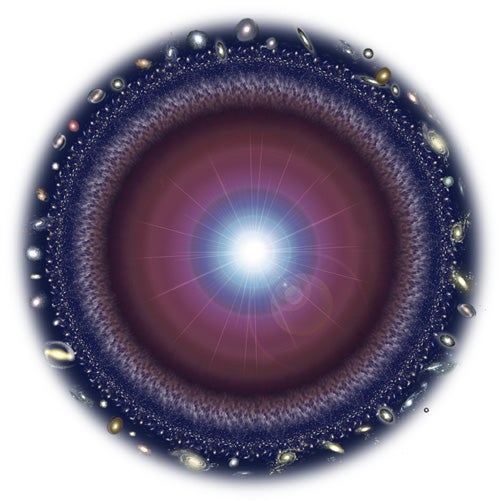I’m Astronomy magazine Associate Editor Liz Kruesi. Welcome to Cosmology 101.
In this series I’ll give you an overview of important ideas in the area of cosmology. This video is the first in the series, and focuses on the Big Bang theory.
Most of the confusion about the Big Bang revolves around two different incorrect ideas. The first is that the Big Bang theory discusses the origin of the universe. The second is that the Big Bang was an explosion. Here I’ll explain what the Big Bang theory really states.
Ever since 1929, astronomers have known the universe is expanding. Edwin Hubble observed that all galaxies except the closest ones to us — which are those in our local group of galaxies — are moving away. In fact, the farther away a galaxy is, the faster it is receding. This expansion isn’t motion through space. It’s the expansion of space itself.
So, if space is expanding, then the universe must be slightly bigger, cooler, and less dense than it was yesterday. If we extrapolate backward, then in the earlier days the universe must have been smaller, hotter, and denser than observed today. So the universe must have begun in a very hot and very compact state. It’s been expanding and therefore cooling for the past 13.7 billion years. For a time after the “beginning event,” the universe was so hot that atoms couldn’t form.
The cosmic microwave background — called the CMB for short — also provides evidence to back up the Big Bang theory. The CMB is an amazingly uniform microwave glow that’s in every direction in the sky. What could have caused a microwave background? Well, as the universe expands, its light is stretched — or redshifted.
The CMB light has been traveling through space since electrons and protons first combined into atoms some 380,000 years after the Big Bang. That light has stretched to microwave wavelengths by now. The CMB shows that a long time ago, the universe must have been smaller and denser than it is now.
The term “Big Bang” actually refers to the moment when the universe started expanding. In fact, another common confusion is that today we can point to a spot where the Big Bang occurred. The truth is that everything in the universe — every point, every galaxy — originated from the same tiny, infinitely dense point 13.7 billion years ago. So really the Big Bang happened everywhere.
Interestingly enough, an astronomer discussing a competing theory coined the term “Big Bang.” In the late 1940s Fred Hoyle was on a radio show to talk about the Steady State Model, and referred to the expanding universe model as “the big bang idea.” The term stuck, and has caused plenty of confusion since. Instead of the term “Big Bang theory,” a better term for the model of our universe would probably be the “expanding-universe theory.”
I hope this overview helped you understand the Big Bang theory a little better. I’ll be back in a few months to talk more about cosmology. And for in-depth articles about cosmology, make sure to check out Astronomy magazine, which regularly features cosmology articles, in addition to frequent cosmology news.
Expand your knowledge at Astronomy.com
Check out the complete Astronomy 101 series
Learn about our stellar neighborhood with the Tour the Solar System series
Read about the latest astronomy news










